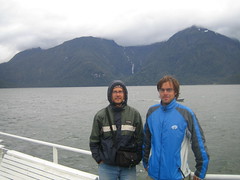This is a bit of a cut and paste job as we had some computer trouble. (third attempt now)
Clayton here. A few days ago we went for a bike ride. "El camino mas peligroso del mundo" roughly translates to: the most dangerous road in the world. The tour we joined was called "The Death Road". Piet tells me there was a National Geographic article on this road. The "road" starts just outside of La Paz at 4700m and soon becomes little more than a path, single track gravel, carved into the side of a green mountain. It ends 30kms later, just before Coroico, at 1200m, taking us five hours with stops. Ascending vehicles are given the right of way, so when they meet, the descending bus or truck must grind to a halt and reverse until finding a spot where they can squeeze by. We were able to travel much faster than the traffic, so we made several narrow passes, with school kids waving out the bus windows, close enough to touch. At times our bike tires were no more than four inches from the brink, allowing us to see straight down. You simply would not survive the fall. I have no official stats, but they told us the last tourist to meet his doom was in 2001. Piet was nearly run off the road by a cargo truck, but he came away smiling. My front tire popped, and going over the handle bars I managed to catch a tree to save myself from being the next statistic. Just kidding. I did blow a tire, but it's not quite as dangerous as we make it out to be. In fact it was the most fun we've had on the entire trip, and I would do it again in a heartbeat. The scenery was stunning, and trying to keep up to our guide reminded me of my childhood, trying to catch my big brother. Never could until he put on the brakes. Anyway, the tour ended with lunch and a three hour van ride back up, which I slept through. Now we are in Copacabana, on the shores of lake Titicaca, the highest navigable lake in the world (though I don't really know what that means). Yesterday we visited the Isla del Sol (island of the sun), said to be the birthplace of the Inca race. There were a couple of interesting ruins, like mazes of stone. One was a temple with blackened ceilings, presumably from ancient sacrifices. Also quite stunning was the staircase leading up the east side of the island.
That's about it for now. Kind of sad to be leaving Bolivia, but we know Peru holds some treasures for us too.
And the last few days have been pretty relaxing. We found a very friendly church yestreday, here in Arequipa, and the only thing of note today was the "Juanita" museum. Juanita is a frozen mummy. Found on top of a mountain in 1995, she was an Inca sacrifice over five hundred years ago. Apparently this was common practice. A volcano would erupt, melting the snow of the nearby mountain, and to appease the volcanic/mountain gods a troop of priests would trek to the 6000m summit, bringing with them the sacrificial child. Chosen from a noble family, he or she would be prepared from birth for this moment (should the need arise before they turned 18, at that time marrying and enjoying a normal life, while the next in line assumed the responsibility). The ceremony would begin with a fermented drink, rendering the child unconscious. It would end in death with a blow to the head. Buried with various offerings (such as gold and silver figurines, different crops from the regions of the empire, alpaca and vicuña textiles, even the umbilical cord and the first fingernail clippings of the child) she would soon be covered by fifty metres of ice and snow, immaculately preserved for us to find after a similar volcanic eruption. You can even see her eyelashes. Being the best preserved of 18 mummies found in Peru and Argentina, she is kept in a glass vault at minus 20 degrees, awaiting new technology to discover the secrets she still holds. Strange and interesting. As we were not permitted to take cameras into the museum you'll have to search for pictures on the net.
By Wednesday we should be in Cusco, ancient capital of the Inca empire, now the gringo capital of South America, and we should post again after visiting Machu Picchu. Until then.


2 Comments:
and we're so happy to see you can now post more pictures!
Nora
In the 1930's and 40's the road along Kootenay Lake may not have had as deep of drop offs but the corners were so tight the bus had to do a 3 (or more) point turn to get around them.
I love reading your adventures but I have no desire to bicycle the Road of Death.
Nora
Post a Comment
<< Home